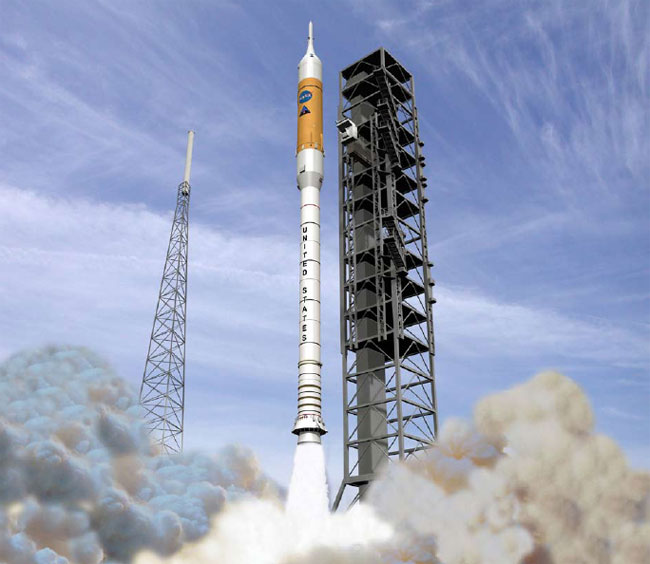Report: More Support, Testing Needed for NASA Exploration

The technology storehouse supporting NASA's effort to launch astronauts back to the moon by 2020 is dependent on proper funding and clear mission goals, but lacks a comprehensive testing plan, according to a new report.
Released Thursday by the National Research Council, the 158-page report stemmed from a 10-month review of NASA's Exploration Technology Development Program (EDTP), which is charged with developing and providing the new technologies required for the agency's return to the moon and beyond.
NASA currently plans to retire its three aging space shuttles by 2010 after completing construction of the International Space Station. Their replacement, the Orion Crew Exploration Vehicle, is slated to make its first crewed flight no earlier than 2014 atop the new Ares I rocket.
"We need a little more time to digest it," said NASA spokesperson Gray Hautaluoma at the agency's headquarters in Washington, D.C., of the report. "We always are appreciative of any analysis and advice."
A committee of 25 veteran aerospace experts took part in the independent review — entitled "A Constrained Space Technology Development Program" — which found that NASA's 22-project technology development program is making progress toward its goals to support the agency's moon effort.
But there was room for improvement, particularly in communicating the risks and human health factors associated with new technologies, as well as with longer term projects aimed at reaching past the moon to Mars and beyond. Other hurdles include federal budget limitations and shifting requirements of NASA's Constellation program overseeing the development of Orion, Ares I, the new Altair lunar lander and its heavy-lift Ares V rocket.
"This was and is a resource-challenged technology development program, but that technology is necessary for future human exploration," said former astronaut Bonnie Dunbar, president CEO of the Museum of Flight in Seattle who co-chaired the review committee. "Even the most talented of engineers and scientists will find it difficult to make forward progress without the necessary tools to do so."
Get the Space.com Newsletter
Breaking space news, the latest updates on rocket launches, skywatching events and more!
The review also stressed the lack of an integrated test program for several EDTP projects "that are needed to advance the technology to technology readiness level."
Because of NASA's short-term focus on returning to the moon and limiting the gap between the space shuttle retirement and the first operational Orion flights, the agency has canceled some longer-term programs — such as nuclear thermal rocket propulsion — that could be important for long range missions to Mars, the report stated. More progress on the effectiveness of technology that will allow astronauts to battle pervasive moon dust, tap into off-planet resources and monitor their environment is also required, it went on.
Dunbar said that while the committee worked hard to provide an objective assessment, it does firmly support the national vision to continue human space exploration to the moon and Mars.
"We hope that this report will help to strengthen that road to the future, not cause it to be questioned," she said in an e-mail interview.
Hautaluoma told SPACE.com that NASA officials will meet with the NRC review panel to further discuss their findings at a later date.
The NRC report is the second in as many weeks stressing the need for more stable federal funding and requirements for NASA's Constellation program. An earlier report, released Aug. 11 by the independent Aerospace Safety Advisory Panel, stressed that budget limitations and the lack of a clear direction for the Constellation program posed significant challenges for the project.
NASA Constellation program managers said then that it was primarily budget concerns that prompted the agency to push back its internal target for the first crewed launch of Orion by one year to 2014. The space agency remains confident that its Orion shuttle successor will meet its official deadline to begin operational flights into orbit no later than 2015, they added.
Join our Space Forums to keep talking space on the latest missions, night sky and more! And if you have a news tip, correction or comment, let us know at: community@space.com.

Tariq is the Editor-in-Chief of Space.com and joined the team in 2001, first as an intern and staff writer, and later as an editor. He covers human spaceflight, exploration and space science, as well as skywatching and entertainment. He became Space.com's Managing Editor in 2009 and Editor-in-Chief in 2019. Before joining Space.com, Tariq was a staff reporter for The Los Angeles Times covering education and city beats in La Habra, Fullerton and Huntington Beach. In October 2022, Tariq received the Harry Kolcum Award for excellence in space reporting from the National Space Club Florida Committee. He is also an Eagle Scout (yes, he has the Space Exploration merit badge) and went to Space Camp four times as a kid and a fifth time as an adult. He has journalism degrees from the University of Southern California and New York University. You can find Tariq at Space.com and as the co-host to the This Week In Space podcast with space historian Rod Pyle on the TWiT network. To see his latest project, you can follow Tariq on Twitter @tariqjmalik.









